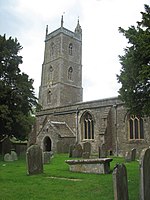Brockley Combe is a wooded combe near the village of Brockley in North Somerset, England. The combe cuts into the western edge of the Lulsgate Plateau, the Carboniferous limestone hills which form a northern outlier of the Mendips, south west of Bristol.
Bristol International Airport lies at the top of the combe. A minor road runs along the length of the combe, meeting the A370 at the lower end, near the village of Brockley.
The name arises as a very rare co-joining of two Brythonic words; combe meaning 'a small deep dry valley, easily defended', and Brock meaning 'badger'. Combe is spelt differently in other part of the United Kingdom as Coombe and Coomb, but the meanings are the same.
The National Gazetteer of Great Britain and Ireland, published in 1868, describes Brockley Combe as follows: "Near the village, on the south-east, is Brockley Coomb, a deep narrow glen, of singular beauty, sunk between steep rocks, rising at some points to the height of 300 feet. It is adorned with many noble trees, and all the fissures and ledges of the cliffs are enriched with a great variety of mosses and other forms of vegetation. Lead ore is found here, and there are masses of columnar basalt."Two identically named poems were written about the combe. Brockley Coomb by British Romantic poet Samuel Taylor Coleridge, which is subtitled Lines composed while climbing the left ascent of Brockley Coomb, May 1795; and Brockley Coomb by British poet Arthur Hugh Clough. John Marius Wilson said that Brockley Combe was a "favourite resort of Coleridge".To the south is another, more undisturbed, combe, Goblin Combe.







